What do you know about Weddell Seals, one of the top predators in Antarctica? What do you know about the people that study them? What do they do and how? What questions do they ask?
For the past 42 years, researchers have been studying these seals in Antarctica. Representing one of the longest field investigations of a long-lived mammal in existence, this study has tagged over 20,000 seals since 1968. In fact, since 1980, almost all pups that have been born in an area about 10 miles north of McMurdo have been tagged by researchers.
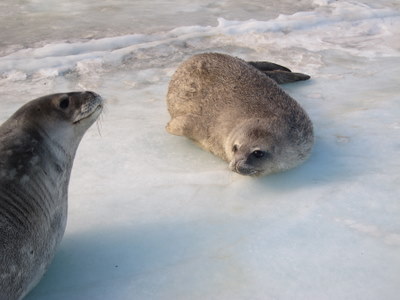
For the past nine years, the research has been guided in part by Bob Garrott, a scientist who devotes half the year to these seals and the other half to working in Yellowstone, studying the prey of wolves and bears. He says, “Sometimes we study the animals that get eaten and sometimes we study the ones who eat. Here in Antarctica, it’s easier to study the predators, the seals… In Montana, it’s easier to study the prey.” Bob not only works with intriguing animals in fascinating places, but he can connect findings from one part of the predator-prey cycle to the other. He can compare the system here in Antarctica, where the human effects are minimal, to a system in the United States, where sadly humans have greatly affected the environment. Bob is joined by a group of eight, including Jesse and Thierry, two guys we had met back at Happy Camper School who, along with Glenn, another PhD student, had also adopted a WATER DROP. (see http://www.polartrec.com/expeditions/antarctic-seafloor-ecology/journals/october-31-2010-hello-the-weddell-seal-researchers-t)
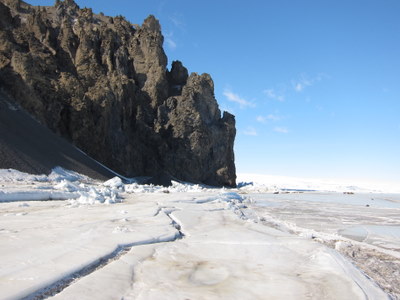
I had wanted to talk to these researchers, to catch a glimpse of what their work was like, but weather, field camp, and work duties kept holding me back. Last Friday, factors finally worked in my favor. The weather was a bit windy but clear and warm, ski-doos were available, our ICE AGED SCINI expert, Bob was happy to be my driving buddy, and the seal group had time for me to visit. I could deviate from helping my team with our seafloor critters to spend time with Weddell seals and the people that study them!
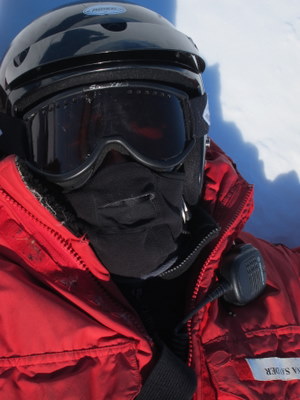
Bob Zook and I jumped on ski-doos and drove a good 30 minutes north on the ice. We headed to a little island in front of Ross Island called Big Razorback, where the seal researchers have their field camp. They have been out there all season, since early October, sleeping in huts and spending the days out on the ice. Every day, they jump on ski-doos, head to a different area on the ice, and look for groups of seals. One of their jobs is to tag every single mother and pup in the area and, so far, they have tagged about 99% of them. This represents about 600 new pups as well as about 100 adults whose tags had been torn out or broken.
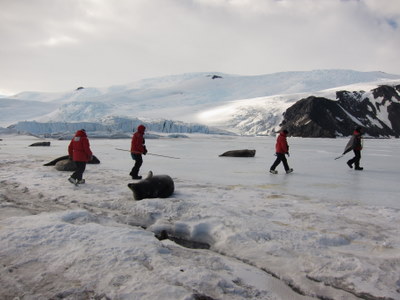
Bob and I met up with part of the group, Bob Garrott, Glenn, and Shawn Farry, their biology technician, at a place about 10 minutes from their camp. The spot was called Turks Head and it was a beautiful area of sea ice interrupted by long, jagged cracks and pressure ridges and decorated with sausage-shaped seals and pups. Dotted with seal excrement and blood, it was bordered by the fissured end of a glacier.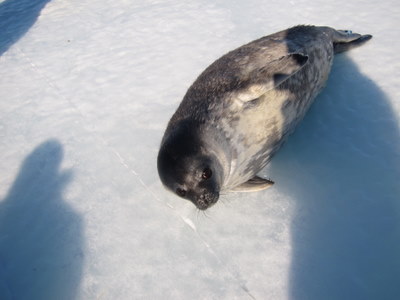
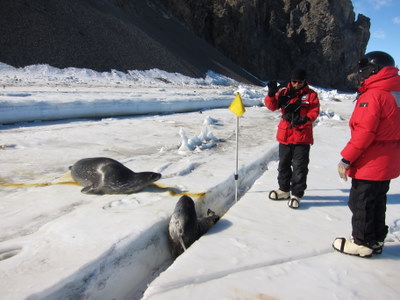
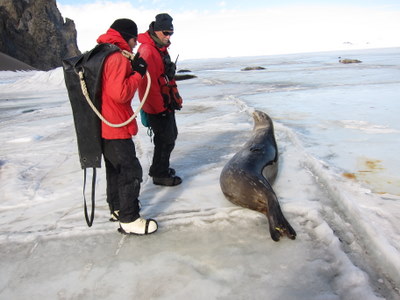
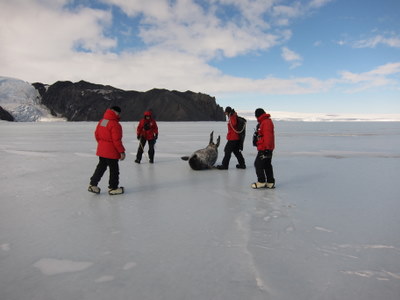
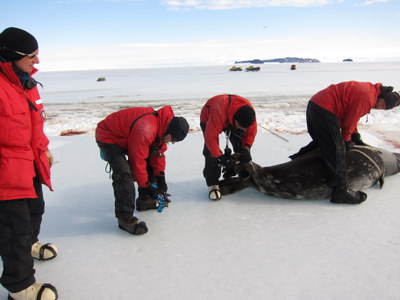
A second part of their daily work involves weighing and tagging pups. Pups are given one day after their birth and then, within the next 5 days, they get their tags and they get weighed. Then, 20 days later and again 15 days after that, they are weighed again. By weighing the pups, the researchers can see how much weight they are gaining, and by tagging them, they can follow them throughout their lives in various ways. This year, they are also trying to determine when they first enter the water. A temperature setting on the tag reads the surrounding temperature of the seal which is all over the place when the seal is on the ice. When the seal is ready to learn how to hunt and feed, it enters the water with its mother and the temperature becomes constant, the temperature of the water -1.7 degrees C.
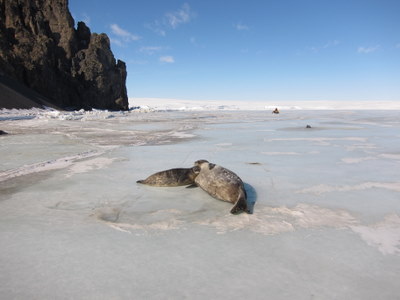
Once again, we observed Bob, Glenn, and Shawn at their task. It was almost over before it began! One minute we were all walking around on the ice and then, before I knew it, they had captured the seal in something that looked like a duffel bag. Two of them then heaved a bar on their shoulders with a simple scale that connected to the duffel bag. Standing up, they were able to lift the pup to determine its weight. Within seconds the pup was free again and the researchers had their data. Now they can enter it into their spreadsheet and add it as another case study to this observational study of seals. The more seals they track, the more accurate their data becomes.
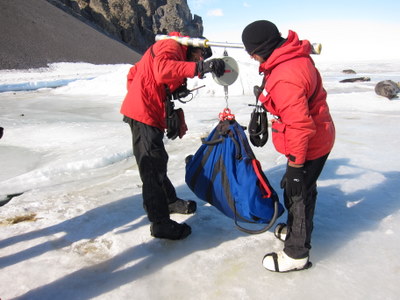
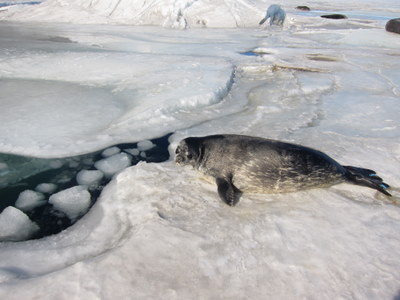
By seeing how much the seals weigh at different points in their early life and then by tracking them, they can learn how weight affects their life. Will the seals that are heavy early on be more likely to survive and return in 5 years, when they are old enough to return to this area to start having their own pups? Will the seals that are heavy at 35 days of age be more likely to have pups earlier – at 6 not 7 or 8 years of age? Will the seals that start off heavy but then gain little weight, have many pups over the course of their life or few? What will happen when the climate is warm or ice? Which seals will survive and have pups then?
These are all questions that the researchers are studying. Only over the course of many years and many seasons of fieldwork, of careful tagging, weighing, and analyzing, will answers be found. Just like our study, one season is not enough.
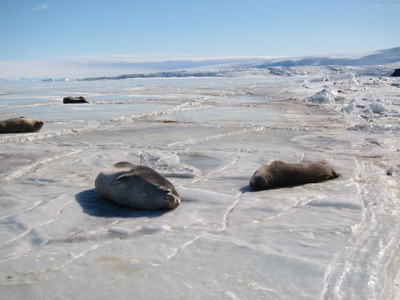
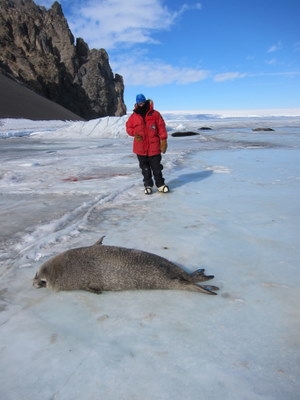
To help the researchers and to help all of us learn more about these seals, various collaborators work with Bob. Geneticists are now getting involved to determine which genes affect things like body mass and reproduction and another group is experimenting with remote sensing devices that can count seals from the air while Bob and his team laboriously walk around the entire area to visually count each seal. What could our team with SCINI do to help them with their seals?
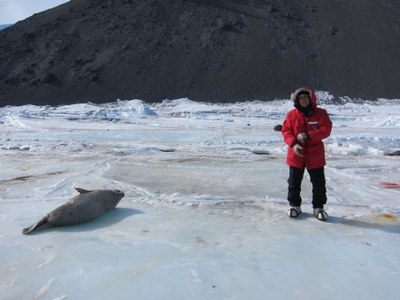
Overall, I am reminded once again by the uniqueness of this place. What will we learn next? Who will study what and how?


Comments